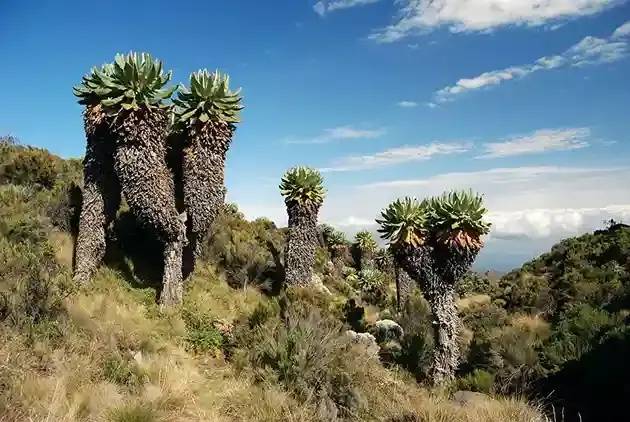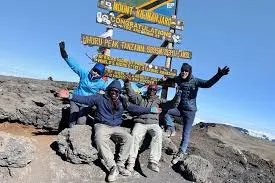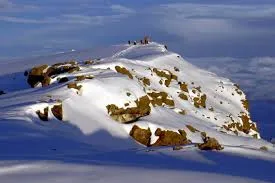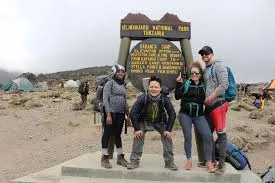Kilimanjaro’s Unique Ecosystems and Climate Zones
When climbing Kilimanjaro, you’ll journey through five distinct climate zones, each with its own scenery, temperatures, and challenges. The trek begins in lush rainforest, then transitions into heath and moorland before reaching the stark alpine desert and the icy arctic summit. As you ascend, temperatures drop significantly and conditions become harsher, making preparation and layering essential. Below is an overview of Kilimanjaro’s unique ecosystems and climate zones to help you understand what to expect on your 6–9 day adventure with Capable Africa Tours.
Plan Your Kilimanjaro Trek Now
Why Explore Kilimanjaro’s Ecosystems and Climate Zones?
Exploring Kilimanjaro’s ecosystems and climate zones lets you experience five unique environments—from lush rainforest to arctic summit—all on a single trek. It’s like walking from the tropics to the poles in just a few days, offering incredible biodiversity, dramatic landscapes, and a deeper appreciation of the mountain’s natural wonder. With Capable Africa Tours, you’ll traverse these zones on expertly guided treks, learning about the mountain’s biodiversity while enjoying high summit success rates (85–90% on 8-day itineraries). Below, we explore each ecosystem, its climate, and how to prepare for this extraordinary adventure.
Kilimanjaro’s Five Ecosystems
- Cultivated Land (800–1,800 m): Fertile farmlands with coffee and banana plantations, home to local Chagga communities.
- Rainforest (1,800–2,800 m): Lush, humid forests with colobus monkeys, blue monkeys, and vibrant birdlife like turacos.
- Heath and Moorland (2,800–4,000 m): Grassy heathlands and moorlands with giant heathers and scenic views of Shira Plateau.
- Alpine Desert (4,000–5,000 m): Arid, rocky terrain with sparse vegetation, offering stark beauty and clear summit views.
- Arctic Summit (5,000–5,895 m): Icy, windswept peaks with glaciers and snow, home to Uhuru Peak, Africa’s highest point.
Climate Zones of Kilimanjaro: A Detailed Breakdown
Kilimanjaro is like climbing through different worlds in one journey. Starting with the warm cultivation zone at the base, you’ll move into the lush rainforest, then the cooler heath and moorland. Higher up, the air gets thin and dry in the alpine desert, and finally, you’ll reach the icy, windswept arctic summit. Each zone has its own climate, scenery, and challenges—so be ready to adjust your clothing and pace as you go. Capable Africa Tours ensures you’re equipped with the right gear and knowledge for each zone.
Climate Zone Details
| Zone | Altitude (m) | Temperature (°C) | Precipitation | Key Features |
|---|---|---|---|---|
| Cultivated Land | 800–1,800 | 20–30 | High (1,000–2,000 mm/year) | Farms, villages, warm and humid |
| Rainforest | 1,800–2,800 | 20–28 | High (1,500–2,000 mm/year) | Dense forest, monkeys, birds |
| Heath/Moorland | 2,800–4,000 | 5–15 | Moderate (500–1,000 mm/year) | Grassy, giant heathers, misty |
| Alpine Desert | 4,000–5,000 | 0–10 | Low (<250 mm/year) | Rocky, sparse vegetation |
| Arctic Summit | 5,000–5,895 | -20 to 0 | Very low (<100 mm/year) | Glaciers, snow, extreme cold |
The rainforest zone feels like a tropical jungle, with mist and bird calls creating an immersive experience. Heath and moorland zones offer open vistas, while the alpine desert’s stark beauty contrasts with the summit’s icy solitude. Capable Africa Tours’ guides share insights into each zone’s ecology, enhancing your trek.
Experience Kilimanjaro’s Ecosystems in Action
Watch this video to see Kilimanjaro’s ecosystems come to life, from vibrant rainforests to icy summits, with Capable Africa Tours’ expert-guided treks.
Flora and Fauna Across Kilimanjaro’s Ecosystems
Kilimanjaro’s ecosystems host an incredible range of flora and fauna, shifting dramatically as you climb. At the base, you’ll find lush rainforests alive with colobus monkeys, blue monkeys, and colorful birds. Higher up, heath and moorland zones feature giant lobelias and groundsels adapted to the cool, misty air. The alpine desert supports only hardy plants like everlasting flowers, while the summit zone is largely barren. Each zone feels like stepping into a new world, offering trekkers a rare chance to witness diverse life within one mountain. Capable Africa Tours emphasizes eco-friendly trekking to preserve these habitats.
Flora Highlights
- Rainforest: Towering camphor trees, ferns, and orchids thrive in humid conditions.
- Heath/Moorland: Giant heathers, lobelias, and groundsels create a surreal landscape.
- Alpine Desert: Hardy lichens and mosses survive in harsh, dry conditions.
- Arctic Summit: Virtually no vegetation, with ice and rock dominating.
Fauna Highlights
- Rainforest: Colobus and blue monkeys, turacos, hornbills, and occasional leopards.
- Heath/Moorland: Small mammals like rock hyraxes and birds like white-necked ravens.
- Alpine Desert/Arctic: Minimal wildlife, with occasional birds like alpine chats.
Kilimanjaro hosts over 1,200 plant species, 140 mammal species, and 180 bird species, with 90% of biodiversity concentrated in the rainforest zone. Capable Africa Tours’ guides are trained to spot and explain these species, enriching your trek.
Preparing for Kilimanjaro’s Climate Zones
Trekking Kilimanjaro requires preparation for diverse climates, from humid rainforests to freezing summits. Capable Africa Tours provides gear rentals and expert advice to ensure comfort and safety across all zones.
Packing Checklist for Climate Zones
- Rainforest (Warm/Humid): Moisture-wicking base layers, lightweight rain jacket, quick-dry pants.
- Heath/Moorland (Cool/Misty): Fleece jacket, waterproof pants, breathable hiking boots.
- Alpine Desert (Dry/Cold): Insulated jacket, windproof gloves, UV400 sunglasses.
- Arctic Summit (Freezing): 800-fill down jacket, thermal underwear, -15°C sleeping bag.
- General Gear: 30–40L daypack, 3L water bladder, trekking poles, SPF 50+ sunscreen.
Gear Rental with Capable Africa Tours
Rent high-quality gear like sleeping bags, down jackets, and trekking poles from Capable Africa Tours, tailored for Kilimanjaro’s climate extremes.
Best Time to Explore Kilimanjaro’s Ecosystems
The best time to trek Kilimanjaro is during the dry seasons: January–March and June–October. These months offer clear skies, stable trails, and vibrant ecosystem views. Avoid April–May and November due to heavy rains in lower zones.
Seasonal Impact on Ecosystems
| Season | Months | Ecosystem Impact | Pros | Cons |
|---|---|---|---|---|
| Dry (Peak) | Jan–Mar, Jun–Oct | Clear rainforest, vibrant moorlands | Best views, stable trails | Higher crowds |
| Wet | Apr–May, Nov | Muddy rainforest, foggy moorlands | Fewer trekkers, lush greenery | Poor visibility, slippery |
| Shoulder | Dec, early Jun | Mixed conditions, partial clarity | Moderate crowds, decent views | Unpredictable weather |
Ready to Explore Kilimanjaro’s Ecosystems?
Join Capable Africa Tours for a transformative trek through Kilimanjaro’s unique ecosystems. Our eco-conscious tours, expert guides, and 90% summit success rate ensure an unforgettable adventure. Book now!
- 90% summit success rate with 8-day itineraries
- Eco-friendly treks preserving Kilimanjaro’s biodiversity
- Gear rentals tailored for all climate zones
- Expert guides trained in ecology and safety
- All-inclusive packages with meals and transfers
Limited spots for Kilimanjaro treks — book now to explore its ecosystems!
Plan Your Trek Now


